|

NOTES ON THE NOVEL: ISSUE 8
Printable View
A Note on the Maps:
The maps used to illustrate this issue are reproduced
from Collins' Illustrated Atlas of London, published in 1854.
Pip's London would have been that of the 1820s, and Dickens' London,
at the time he was composing the novel, was that of 1860-1. Collins'
maps thus represent a London that falls between the historical moment
represented in the novel and the historical moment of the novel's
composition.
Since Pip arrives in London in the summer of
1823 (Meckier 158), the maps used to illustrate this issue show
a city that has undergone about 30 years of change since Pip's time.
Nevertheless, they are very useful in tracking Pip's progress through
the city; the reader should merely keep in mind that some of the
landmarks would not have existed in 1823. The most significant of
these are the railway lines marked on the Key Map -- the
railroad did not enter London until the late 1830s and early 1840s
(Tallis's Illustrated London 186-7). The Key Map also
shows a bridge that Pip would not have recognized -- the Hungerford
Bridge between Waterloo and Westminster Bridges. And London Bridge
was, in Pip's time, Old London Bridge -- a different structure,
but built in essentially the same place. (New London Bridge would
have begun construction a few yards from Old London Bridge when
Pip was living in London, but would not have replaced the old bridge
during his tenure [Meckier 162]. Given that both London Bridges
would have been mapped in the same place, the difference between
the bridges makes no difference to our reading of the map.) Any
further discrepancies will be noted where appropriate.
History and Features of Collins' Atlas
(1854)
Collins' Atlas was created in response
to the amplified tourist trade in London resulting from the Great
Exhibition of 1851. Previous to the Atlas, maps tended to
be very large and unwieldy, and though large city maps could be
folded up and carried, Collins designed his maps with a specific
view to portability (Dyos 10). The Atlas consists of one
large map of the whole city of London (the Key Map), followed
by 36 plates. The Key Map is drawn with numbered sections,
and these sections are represented in detail by the plates (the
numbers on the Key Map refer to the numbers of the plates).
The chief drawback to the Atlas is that, although the Key
Map keeps North at the top, the plates do not always observe
this convention (Dyos 13). This disregard of the compass, however
puzzling to someone attempting to navigate London in 1854, is in
many respects an advantage for the modern reader: The detailed plates
-- drawn to represent popular views of the city and/or popular routes
through it -- give us a unique view of the sites of Pip's adventures
in 19th century London. Any major discrepancies between the landmarks
shown on the maps and those that Pip would have been acquainted
with (given that the map was composed in 1854, about thirty years
after Pip's tenure in London) will be indicated where appropriate.
A Note on the Illustrations
Like Collins' Atlas, the engraved illustrations
of London reproduced in this and subsequent issue(s) were prepared
as a result of the Great Exhibition of 1851. Tallis's Illustrated
London (published in 1851-2, in two volumes) was created specifically
to commemorate the Exhibition, and furnishes, not only a great many
engravings of London scenes, but also a long history of, and commentary
on, the sights of London. Since Tallis's Illustrated London was
published, like Collins' Atlas, about 30 years after Pip's
tenure in the city, some of the views commemorated in Tallis's
would not have been available to Pip. Thus, only those illustrations
that show cityscapes and landmarks as they would have appeared to
Pip in the 1820s have been included here.
A tour of Chapters 23-26: Pip's early experiences
in London
The Key Map of Collins' Atlas, showing
London as a whole, gives a useful overview of Pip's progress in
this issue. All of the maps reproduced here have been highlighted
for convenience of reference and increased legibility.
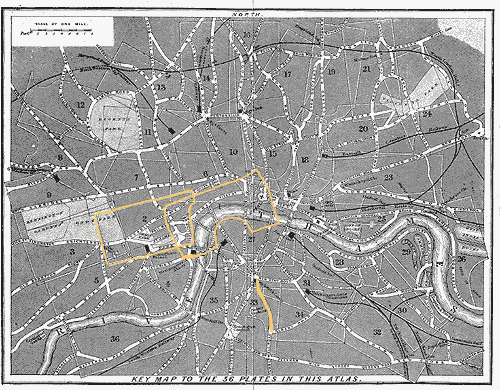
Chapters 23-26 of Great Expectations occur
in the areas marked on the Key Map by numerals 1, 2, and
33/34, as well as in Hammersmith, which is to the west of London
and thus beyond the bounds of Collins' Atlas.
When Wemmick speaks of "getting evidence together
for the Bailey" (Ch. 24), he is preparing for trial. The Old Bailey,
visible on Plate 1 of Collins' Atlas (below) in the lower
left corner, is the street in which Newgate Prison and the Sessions
House stand -- the latter named for the twelve "sessions" held yearly
for the trial of prisoners (Tallis's Illustrated London,
vol. 1, 25-7).
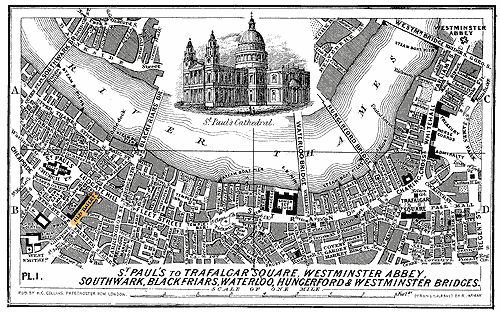
The Sessions House is located, on Plate 1, at
the top of Old Bailey, at the corner of Ludgate Hill. As indicated
previously, Hungerford Bridge, which appears on this Plate, would
not have existed during Pip's time in London.
Tallis's Illustrated London gives illustrations
of both the Sessions House and the Old Bailey.


Wemmick invites Pip to visit him in Walworth,
and the two walk from the office (in Little Britain, near Smithfield)
to Wemmick's home. Walworth at that time (1823) was a sort of developing
suburb, and though Pip does not specify where in Walworth Wemmick
lives, the walk from Jaggers' office to Wemmick's domestic "castle"
would take them south over the Thames, probably via Blackfriars
or Southwark Bridge. The district of Walworth, visible on the Key
Map (see Key Map again above), lies to either side of
Walworth Road. Having undergone significant development between
1823 (when Pip visits for the first time) and 1854 (when the map
was drawn), the plates of Collins' Atlas give a very different
view of Walworth than Pip probably would have had. For instance,
Surrey Gardens, just visible to the left of Walworth Road on the
Key Map, was not opened until 1831 (Tallis's, vol.
2, 240).
Pip dines at Jaggers' residence in Gerrard Street,
Soho (Ch. 26). Gerrard Street, near Piccadilly, is visible on Plate
2 of Collins' Atlas (below), at the bottom left.

I had been to see Macbeth at the theatre ...
her face looked to me as if it were all disturbed by fiery air,
like the faces I had seen rise out of the Witches' caldron:
Pip remembers a scene from Shakespeare's Macbeth, in which
the "weird sisters" -- three witches -- are boiling a potion in
their cauldron. Macbeth comes to them to know his future in Act
IV, scene 1, and is warned by three apparitions -- an "armed head,"
a "bloody child," and a "child crowned with a tree in his hand"
-- which rise from the cauldron, speak to him, and descend into
it again.
Britannia metal: Mr. Jaggers, instead
of keeping silverware, furnishes himself with utensils made of Britannia
metal. The Dictionary of Daily Wants (1858-9) describes this
substance as follows:
BRITANNIA
METAL. -- An alloy composed of block tin, antimony, copper, and
brass. It takes a high polish, does not readily tarnish; and when
kept perfectly bright, nearly approaches the luster of silver.
It is not acted upon by acids, and may be safely used in the preparation
or the partaking of food. A number of domestic utensils are made
from this metal, and their cost being very moderate, they are
brought within the reach of nearly all persons. (201)
Cast ... made in Newgate: Plaster death-masks
of criminals were frequently made after their execution. According
to Charlotte Mitchell, the Romantic writer Thomas de Quincy "mentions
in the notes to his essay 'On Murder Considered as One of the Fine
Arts' that he was able to buy a plaster cast of the 1811 Ratcliffe
Highway murderer, John Williams" (496). These casts, commercially
available, were apparently created with a popular audience in mind:
Though not nearly as grisly as the two busts Jaggers has in his
offices, the etching below of the "Profile of Thurtell, Taken from
a Bust After Execution" (reproduced from an April 1837 issue of
Martin's Annals of Crime or New Newgate Calendar) corroborates
the practice of commemorating the criminal dead in this fashion.
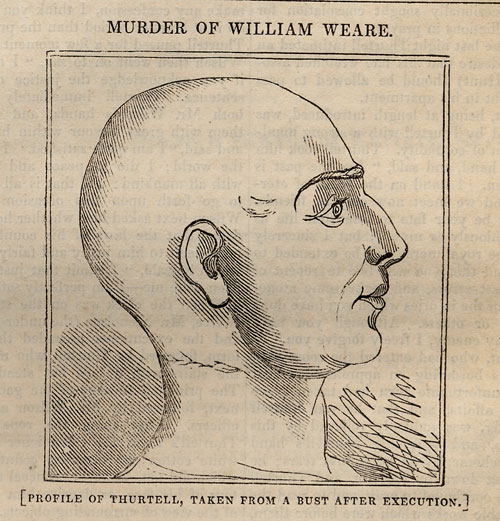
Dumb-waiter: Mr. Jaggers uses a dumb-waiter
at dinner, such that he can keep "everything under his own hand,
and [distribute] everything himself" (Ch. 26). The Dictionary
of Daily Wants (1858-9) gives the following illustration and
description of a dumb-waiter:
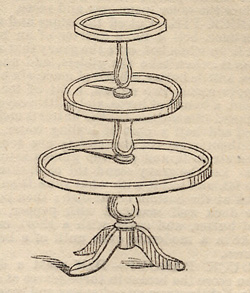
DUMB
WAITER. -- A well-known piece of furniture formerly much in use,
and extremely convenient; the shelves should be made to turn round,
which renders them still more serviceable. (390)
Dutch doll: A Dutch doll is a jointed
wooden doll (OED, "Dutch doll") -- hence the comparison of
one of the Pocket children to this kind of doll: "Flopson, by dint
of doubling the baby at the joints like a Dutch doll, then got it
safely into Mrs. Pocket's lap..." (Ch. 23).
Dying Gladiator: Although properly the
Dying Gaul, the statue to which Mr. Pocket is compared in
Chapter 23 -- the Dying Gladiator -- is a Roman copy of a
Greek statue housed in the Museo Capitolino in Rome (Gardner 176-7).
This statue was popular with the 19th century literary imagination
-- it appears (as the "Dying Gladiator") in Henry James' Portrait
of a Lady and Nathaniel Hawthorne's Marble Fawn, as well
as in Great Expectations. The statue is dated c. 230-220
B.C., and is about 36 1/2 inches high (Gardner 176). A picture of
the Dying Gaul/Gladiator is reproduced here by permission
of AICT.

Courtesy of AICT/(Alan
T. Kohl)
Gold Repeater: Jaggers' watch, which Wemmick
asserts is "worth a hundred pounds if it's worth a penny" (Ch. 25),
is a watch that "chimes the last hour when pressed, and thus may
be consulted in the dark" (Mitchell 497).
Grinder: A grinder is a kind of tutor
-- "one who prepares pupils for examination; a crammer" (OED,
"grinder"). According to Pip, Mr. Pocket, "[a]fter grinding
a number of dull blades -- of whom it was remarkable that their
fathers, when influential, were always going to help him to preferment,
but always forgot to do it when the blades had left the Grindstone
-- ... had wearied of that poor work and had come to London" (Ch.
23). The term "grinder" seems to encourage, if indeed it was not
formulated in, jest: A contemporary usage recorded in the OED
from Thackeray runs as follows: "She sent me down here with a grinder:
she wants me to cultivate my neglected genius."
Roasting-jack: A roasting-jack is a "contrivance
for turning meat, etc., while it is being roasted" (OED,
"roasting-jack"), and the "brazen bijou over the fireplace" to which
it is attached in Wemmick's home (Ch. 25) would be a decorative
fixture in brass. Given the size of Wemmick's house (small), and
the configuration suggested by Pip's description of the roasting
jack, the specific machine in question is probably a "bottle-jack."
Walsh's Manual of Domestic Economy (1858) illustrates several
roasting apparatuses, and makes the following remarks on roasting
and bottle-jacks:
FOR
ROASTING OR BAKING, the kind of grate is of the utmost importance:
it being impossible without a good one to turn out a well-dressed
joint to advantage. It may be said that an open fire will always
dress a joint of meat; and so it will, but not a large or small
one at the choice of the cook, unless the fire is capable of being
made narrow or broad, shallow or deep, according to the shape
of the joint and its mode of suspension....
A SPIT OR HOOK for suspending the meat, with some kind of machinery
for turning it, is the next in importance to the fire.... [Such
an implement for suspending and turning the meat is] the bottle-jack
(fig. 111a), which, by means of common clock-work, keeps
up a constant revolution of any article attached to the hook (b).
The objection to this kind [of jack] is that a fire can with difficulty
be made equally strong at the top and bottom, and, consequently,
the joint is roasted either too much or too little in one or other
of its ends. But being of a comparatively low price it is often
used, and succeeds well enough for poultry, game, or small joints....
(445)
A picture of the bottle-jack (fig 111)
from Walsh's Domestic Economy:
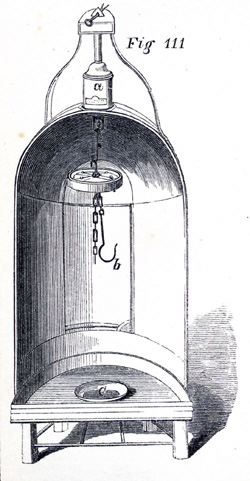
Tobacco-stopper: According to the OED,
a tobacco-stopper is "a contrivance for pressing down the tobacco
in the bowl of a pipe while smoking."
Woolsack, or ... mitre: When Pip remarks
of Matthew Pocket that, "in the first bloom of youth, [he had] not
quite decided whether to mount the Woolsack or to roof himself with
a mitre" (Ch. 23), he refers to two prospective professions for
Mr. Pocket: The woolsack is associated with the seat-cushioning
in the House of Lords, and specifically with the Lord Chancellor.
According to the OED, the woolsack is "A seat made of a bag
of wool for the use of judges when summoned to attend the House
of Lords (in recent practice only at the opening of Parliament);
also, the usual seat of the Lord Chancellor in the House of Lords,
made of a large square bag of wool without back or arms and covered
with cloth. Often allusively with reference to the position
of the Lord Chancellor as the highest judicial officer; hence, the
woolsack, the Lord-Chancellorship; on the woolsack, in
this office." The mitre, on the other hand, was a priest's headdress
(OED, "mitre").
Bibliographical
information
|

